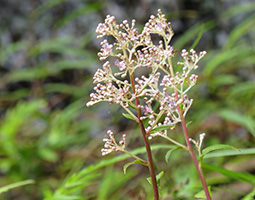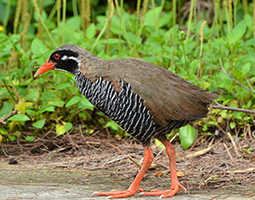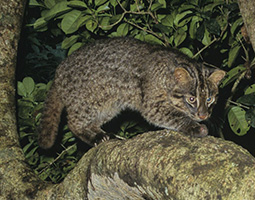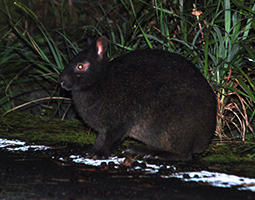INDEX
- English
- 日本語

A mangrove forest on Iriomote Island - English
- 日本語

Iriomote Island viewed over a small island in the emerald green ocean

Amamikusa hydrangea, endemic to Amami-Oshima Island 
Okinawa rail, endemic to the northern part of Okinawa Island 
Iriomote wildcat, endemic to Iriomote Island 
Amami rabbit, endemic to Amami-Oshima Island and Tokunoshima Island
November 2021
Islands of Biodiversity

The Ryukyu Islands are a chain of islands at the southern tip of the Japanese archipelago and extend approximately 1,200 kilometers from south to north. Four of these regions, Amami-Oshima Island, Tokunoshima Island, the northern part of Okinawa Island, and Iriomote Island, were registered as a UNESCO World Natural Heritage site in July 2021.

In July 2021, Amami-Oshima Island, Tokunoshima Island, the northern part of Okinawa Island, and Iriomote Island were registered as Japan’s fifth World Natural Heritage site. Straddling Kagoshima Prefecture and Okinawa Prefecture, these four areas are part of the Ryukyu Islands and are home to extensive subtropical forest. They were inscribed on the World Heritage List because of their rich biodiversity.
Naniwa Nobukazu, national park planning officer at the Okinawa Amami Nature Conservation Office of the Ministry of the Environment, explains about the regions’ biodiversity: “The listed regions have a total area of roughly 43,000 hectares, a small zone that is less than 0.5 percent of Japan’s land area, yet they are home to 95 globally endangered species, 75 of which are endemic only to this region.”

The Ryukyu Islands, including these four regions, split off from the continent some 12 million years ago due to movement of the Earth’s crust. Later, changes in the climate caused the islands to separate and join with neighboring islands again and again. As a result, the islands are home to many endemic species, including relict endemic species that became extinct on the mainland and survived only on the island along with new endemic species that have evolved in their own unique way to adapt to the specific environment of each island.
The four regions currently account for a high proportion of Japan’s endangered species. These include the Amami rabbit* on Amami-Oshima and Tokunoshima, the Okinawa rail** in the northern part of Okinawa Island, and the Iriomote wildcat*** on Iriomote Island, all of which have been designated as Special Natural Monuments.

The natural environment of the four regions that sustain these rare and endangered species is exceptionally rich.
Amami-Oshima has a pristine, tunnel-like mangrove forest that can be explored by canoe. Rare plants such as the Amamikusa hydrangea**** can also be spotted.

Tokunoshima runs a variety of eco-tours led by local guides. One is the Night Tour, where visitors can go by car in the mountains or along forest trails to observe the Amami rabbit. The Night Tour offers the potential for visitors to sight the Amami rabbit, a nocturnal primitive animal.
The northern part of Okinawa Island still has many mountains and forests. The lush subtropical evergreen is called “Yambaru” and there are many places to see.

Over 90 percent of Iriomote Island is covered in subtropical jungle forest. A distinctive summer sight is the well-known common putat*****, a type of powderpuff tree, which blooms at night and scatters its petals in the morning. A canoe ride through a mangrove forest to see the flowers in bloom is a popular activity.
With the registration of the four regions as a World Natural Heritage site, Naniwa and others involved with environmental conservation in the area are now focused more than ever on promoting ecotourism and preserving the endangered and endemic species of these island regions.
* (Pentalagus furnessi)
** (Gallirallus okinawae)
*** (Prionailurus bengalensis iriomotensis)
**** (Cardiandra amamiohsimensis)
***** (Barringtonia racemosa)

